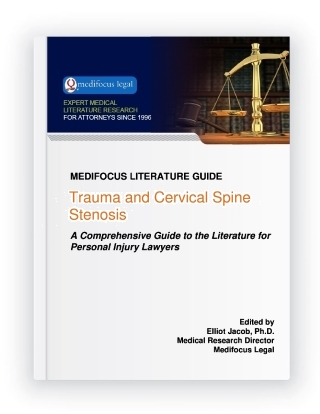Trauma and Cervical Spine StenosisA Comprehensive Guide to the Literature for Personal Injury Lawyers
Publisher: Medifocus Legal
Publication Date: February 28, 2023
Number of Pages: 60
A Comprehensive Guide to the Literature for Personal Injury Lawyers
Publisher: Medifocus LegalPublication Date: February 28, 2023
Number of Pages: 60
* Neck pain
* Numbness or tingling in the affected arm or hand
* Weakness of the affected arm/hand
* Loss of function in severe cases
Cervical spinal stenosis is typically diagnosed by performing a thorough patient history and a physical examination. Imaging studies such as X-rays, MRI, or a CT myelogram are used to determine the precise location, type, and extent of the stenosis. The treatment depends upon the severity of the symptoms and the extent of neurological deficits, if present. In general, the treatment options include physical therapy, anti-inflammatory pain medications, cortisone injections, and decompression surgery (with or without spinal fusion).
Most cases of cervical spinal stenosis develop in patients over age 50 and result from from normal aging and wear and tear (osteoarthritis) of the spine. Arthritis of the ligaments that hold the spine together can cause these ligaments to thicken over time and bulge into the spinal canal resulting in stenosis. Some people can develop spinal stenosis if they are born with a either a small spinal canal or an abnormally shaped spine (scoliosis0.
It is also recognized that a subset of patients with cervical spinal stenosis have a history of trauma. Since spinal stenosis typically develops slowly over time, the precipitating trauma may have occurred months or even years prior to the onset of stenosis symptoms.
Over the past few decades, a number of studies have been published in the medical literature that examined the issue of whether trauma to the neck from a motor vehicle accident or a fall can cause cervical spinal stenosis. Some studies have also examined the question of whether trauma can elicit the symptoms of stenosis in patients with pre-existing cervical stenosis who were asymptomatic prior to the trauma.
The MediFocus Literature Guide to Trauma and Cervical Spine Stenosis is a comprehensive reference guide to the literature that is designed to provide personal injury lawyers with a detailed overview of the scientific evidence regarding the role of trauma in development and/or exacerbation of cervical spinal stenosis.
 |
- A comprehensive bibliography of 64 journal article references indexed in MEDLINE published in well respected medical and scientific journals.
- Online access to the abstracts (summaries) of the articles.
- Online access to the free full-text version of 10 articles.
- Links to full-text sources of other articles that are available for purchase directly from individual journal publishers.
- A unique "Author Directory" consisting of the names and institutional affiliations of experts who have published and have specialized knowledge about Trauma and Cervical Spine Stenosis. The "Author Directory" is a valuable resource for quickly identifying and locating experts for case reviews, opinions, and testimony.
Select examples of topics that are covered by the articles referenced in this Guidebook include:
- The Risk of Acute Spinal Cord Injury After Minor Trauma in Patients With Preexisting Cervical Stenosis.
- Predicting the risk and severity of acute spinal cord injury after a minor trauma to the cervical spine.
- Cervical spinal canal narrowing and cervical neurological injuries
- Cervical neural space narrowing during simulated rear crashes with anti-whiplash systems
- Spinal cord injury in cervical spinal stenosis by minor trauma.
- The relationship between spinal stenosis and neurological outcome in traumatic cervical spine injury.
- Late whiplash syndrome: a clinical science approach to evidence-based diagnosis and management.
- Head-turned rear impact causing dynamic cervical intervertebral foramen narrowing: implications for ganglion and nerve root injury.
- Dynamic intervertebral foramen narrowing during simulated rear impact.
- Multiplanar cervical spine injury due to head-turned rear impact.
- Spinal canal narrowing during simulated frontal impact.
- Speed bump-induced spinal column injury.
- Spinal canal narrowing during simulated whiplash.
- Stingers, cervical cord neurapraxia, and stenosis.
- Trauma-induced myelopathy in patients with ossification of the posterior longitudinal ligament.
- The relationship of developmental narrowing of the cervical spinal canal to reversible and irreversible injury of the cervical spinal cord in football players.
- Cervical spinal stenosis with cord neurapraxia and transient quadriplegia.
- Influence of minor trauma to the neck on the neurological outcome in patients with ossification of the posterior longitudinal ligament (OPLL) of the cervical spine.
- Decreased width of the spinal canal in patients with chronic symptoms after whiplash injury.
- Late post-traumatic spinal stenotic progressive myelo-radiculopathy.
is available in two formats: | |
Order by Phone:To order by phone, please call: Order by Mail:To order by mail, please print and complete this Order Form | |

